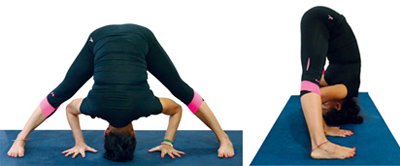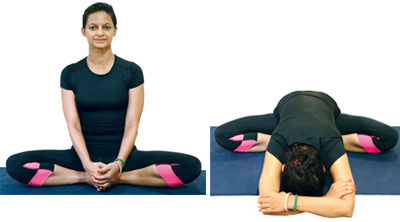During a recent seminar on PCOS, a gynaecologist revealed that till a few decades ago, during their annual presentations, only one paragraph would be allotted to PCOS. Today, there are long presentations just on this one topic.
Estimates suggest that Polycystic Ovary Syndrome [PCOS] affects 5 – 10 per cent of women of reproductive age. The symptoms of PCOS are any or all of the following: hair fall, irregular menstruation, acne, pimples, baldness, dandruff, miscarriage, facial hair, weight gain, high blood pressure and sugar imbalances due to insulin resistance. PCOS also increases the risk of heart attack, diabetes, stroke, anxiety disorder, depression and uterine cancer.
But every problem has an inherent solution. The good news is that a regulated and disciplined lifestyle can reverse this problem. “PCOS is growing like an epidemic due to faults in the lifestyle, especially, in young girls. It can be completely kept under control without any complications through yoga, right diet and a healthy lifestyle,” says Dr Sudeshna Ray, Mumbai-based gynaecologist.
PCOS increases the risk of heart attack, diabetes, stroke, anxiety disorder, depression and uterine cancer
Let’s look at how yoga can help to manage PCOS
To treat PCOS, it is important to focus on the postures which help direct oxygen rich blood to the reproductive organs. Hence, all the asanas which are meant to stretch and expand the lower back and hips will fall in this category.
Prasarita Padotanasana
 [wide legged forward bend]: Stand with your feet wide apart [4 – 5ft], bend forward to place your palms on the floor, inhale, raise your head up to get a concave back, bend your elbows, exhale and place your crown in between your palms. Maintain the posture with normal breathing for a while. Here’s a video to help you do the pose correctly.
[wide legged forward bend]: Stand with your feet wide apart [4 – 5ft], bend forward to place your palms on the floor, inhale, raise your head up to get a concave back, bend your elbows, exhale and place your crown in between your palms. Maintain the posture with normal breathing for a while. Here’s a video to help you do the pose correctly.
Benefits of Prasarita Padotanasana:
- Stimulates your liver, kidneys, calves, hips, groin, knees and spine.
- Calms the mind and releases muscular stiffness.
Upavista Konasana
 Sit with your legs stretched in front of you and spread as far apart as possible. Start bending forward as per your comfort, while exhaling. Your aim should be to finally touch your head to the floor and your hands to your toes.
Sit with your legs stretched in front of you and spread as far apart as possible. Start bending forward as per your comfort, while exhaling. Your aim should be to finally touch your head to the floor and your hands to your toes.
Watch the video below of Upavista Konasana
Benefits of Upavista Konasana:
- Stretches and strengthens your hips, lower spine, and muscles from the upper chest to the pelvis.
- Helps the pelvic floor get increased blood supply.
- Eases the pain of sciatica, regularises menstrual flow, stimulates ovaries, and stretches hamstrings.
- Recommended during pregnancy as well.
Baddhakonasana
 Sit with your feet in Namaste position [soles touching] for 1 – 2 minutes. Slowly bend forward and get into a comfortable, relaxed position as shown in the picture. Watch this video on how to do Baddhakonasana
Sit with your feet in Namaste position [soles touching] for 1 – 2 minutes. Slowly bend forward and get into a comfortable, relaxed position as shown in the picture. Watch this video on how to do Baddhakonasana
Benefits of Baddhakonasana:
- Helps direct blood flow to the abdomen and pelvis thereby stimulating the abdominal organs, ovaries, uterus, bladder and kidneys.
- Helps with sciatica, menstrual irregularity, high blood pressure, asthma, infertility, depression and fatigue.
- Recommended for pregnant woman.
Apart from the ones mentioned above, asanas like utthita trikonasana, utthita parsavakonasana, paschimottanasana and adhomukha svasana are also beneficial. Additionally, the practice of Surya Namaskar alone can bring tremendous benefits and help keep weight in check. Surya Namaskar is a series of 12 postures which stretches and flexes the complete spine, works on the arms and the legs and internal organs and glands.
According to some schools of thought, it is best to avoid inversion postures if you have PCOS.
the practice of suryanamaskar alone can bring tremendous benefits and help keep weight in check
Managing the stress that comes with PCOS
Stress can be a cause of PCOS and also a result of it. Activating your parasympathetic nervous system with restorative postures, correct breathing and pranayama can help manage stress. Pranayamas promote deep relaxation and hormonal balance bringing adrenal and cortisol levels within control.
Ujjayi Pranayama [victory breathing]
Performed at the basic level, one needs to sit upright, and inhale and exhale while constricting the throat. You will hear ‘sa’ sound during inhalation and exhalation.
Benefits of Ujjayi Pranayama:
- Expands your lungs fully so that you utilise your lung capacity to the optimum.
- Generates vital energy, tones and soothes the nervous system, and balances high BP.
Nadi Shodhan Kriya [alternate nostril breathing]
This is popularly known as anulom vilom. You block your right nostril with your right thumb, inhale from the left nostril, then block left nostril with right ring and little finger, release right nostril and exhale. Then inhale from the right nostril, block right nostril again with right thumb, release left nostril and exhale from left nostril. This is one cycle.
Benefits of Nadi Shodhan Kriya:
A few cycles of anulom vilom where you are breathing mindfully can calm your mind, increase oxygen level in the body, relieve fatigue, strain and weakness and also lower high blood pressure.
Mudras for PCOS
These are hand gestures that can be held while doing pranayamas or at any other times during the day.
 1. Gyan Mudra or Jnana Mudra is the mudra of wisdom. This mudra is performed by joining together the tips of the thumb and the index finger. Performing this mudra helps to increase will power. It also balances the function of the various glands and stabilises hormonal disorders. It is beneficial in sleeping disorders. Do this for 15 minutes daily.
1. Gyan Mudra or Jnana Mudra is the mudra of wisdom. This mudra is performed by joining together the tips of the thumb and the index finger. Performing this mudra helps to increase will power. It also balances the function of the various glands and stabilises hormonal disorders. It is beneficial in sleeping disorders. Do this for 15 minutes daily.
 2. Yoni Mudra is performed by joining the thumbs and the index fingers of both hands and interlocking the other fingers. Thumbs will face the ceiling and index fingers will be facing the floor. This mudra is specially designed for woman and helps to relieve PMS, periods irregularity and excess bleeding during periods. Do this for 30 minutes followed by 5 – 10 minutes of Pran Mudra.
2. Yoni Mudra is performed by joining the thumbs and the index fingers of both hands and interlocking the other fingers. Thumbs will face the ceiling and index fingers will be facing the floor. This mudra is specially designed for woman and helps to relieve PMS, periods irregularity and excess bleeding during periods. Do this for 30 minutes followed by 5 – 10 minutes of Pran Mudra.
 3. Pran Mudra is performed by joining the tips of little fingers and ring fingers with the tips of the thumb. It helps reduce tension, anger and irritability. Also relieves skin rashes, improves eyesight and removes impurities from blood. Do this for 10 minutes daily.
3. Pran Mudra is performed by joining the tips of little fingers and ring fingers with the tips of the thumb. It helps reduce tension, anger and irritability. Also relieves skin rashes, improves eyesight and removes impurities from blood. Do this for 10 minutes daily.
Follow the whole series whenever convenient during the day.
Lifestyle management is the key to PCOS management. Hence, look at each aspect of your life, manage it positively and you will be relieved of this health concern.
If you have any further questions about how to manage PCOS with yoga, I will be happy to answer them for you. You may post your questions on ‘Ask Shammi’ segment on www.shammisyogalaya.com.
PCOS, yoga and weight loss
Weight gain is a common effect of PCOS and one that is most upsetting. Hormonal imbalance leads to uncontrollable weight gain. Hence, managing weight is critical to get a grip on the situation. Once in control, it is easier to handle the other issues associated with it.
Yoga postures can be performed in a sequence dynamically to increase heart rate and provide a cardiovascular workout. This accelerates weight loss and also improves the health of the heart. Hatha yoga postures, when performed in its traditional way i.e., holding the posture for a certain period of time, thereby applying the principle of static contraction [isometric type], helps build strength, increase muscle mass and combat insulin resistance. Also, there are asanas that can stimulate different organs and bring hormonal balance.
A version of this article was first published in the February 2016 issue of Complete Wellbeing.
 Spot an error in this article? A typo maybe? Or an incorrect source? Let us know!
Spot an error in this article? A typo maybe? Or an incorrect source? Let us know!

Great Author, Great read,